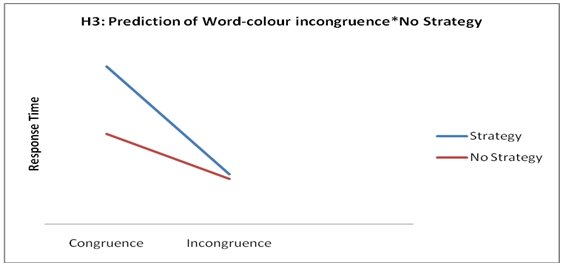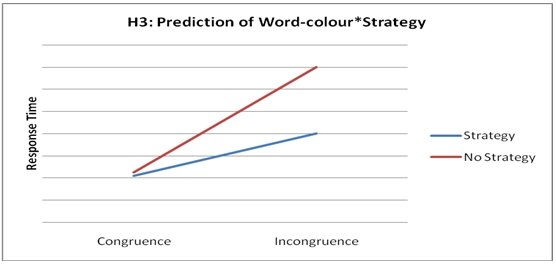Abstract
The research used independent variables of word-colour congruence (IV) and strategy manipulation (IV2) to find out if such strategies and stimuli affected word recognition among respondents. The independent variables were strategy, strategy manipulation, word-colour congruence, and word-colour incongruence.
The result [F (1, 66).478, p =.492] showed lack of interaction effects between word-colour and strategies. There was the main effect of significance value in manipulation of strategies as [F (1, 66) 9.608, p =.003]. In conclusion, word-colour congruence and strategy manipulation have faster response rate in word recognition.
Introduction
In the past decades, scholars have believed that recognition of words happened automatically without the need for additional features and resources for successful recognition (Stroop, 1935; Besner and Stolz, 1999). Contrary to this observation, recent studies have shown that word recognition is fast and certain, but still, there are needs for extra materials for attention (Kellas, Ferrarro and Simpson, 1999).
According to Carr, Davidson, and Hawkins, a strategic approach to word recognition and attention resources indicated that there are influences on recognition of words (Carr, Davidson and Hawkins, 1978). In addition, studies by Manelis, Henderson, Neely, Keefe, and Ross also supported this observation (Henderson, 1982; Neely, Keefe and Ross, 1989; Manelis, 1974).
On this regard, a study by Widau, McMickell, Juola, Milota, and Simpson showed that people can “automatically identify words during lexical access and word recognition and the activation happens strategically contingent upon task demands” (Milota et al, 1997).
This implies that people who have developed reading skills possess strategic control of different coding and recoding processes that we assume influence observed word recognition to the extent that they can recognise such words, or ignore them if such words have negative effects on reading outcomes.
Mario and Ryan looked how word manipulation with regard to stimuli can have effects on word recognition performance (Mario and Ryan, 1990). This also accounted for various strategies that people may use and their flexibility when processing lexical items.
In this experiment, we shall observe the word-colour congruence and existence of strategy manipulation in Stroop task. If these interactions exist, then word-colour and strategy manipulation would be significant. Thus, we shall prove that word recognition relies on colour and strategies.
On the other hand, if no strategy or colour manipulation exists, then we shall conclude that word recognition occurs automatically without external factors manipulation. We can also illustrate whether changes in manipulation strategies or colour congruence affect word recognition. Such evidence can support the idea that readers can control external effects from their abilities to recognise words.
Experimental hypotheses
Based on the research detailed above, the following hypotheses were formulated to determine whether response time is affected by word-colour congruence, strategy manipulation or the interaction of both.
H0: (Null hypothesis) predicts no difference of effect between variables.
H1: (Experimental hypothesis 1) predicts that the response rate for word-colour congruence will be faster than word-colour incongruence.
H2: (Experimental hypothesis 2) predicts that the response rate for strategy manipulation will be faster than the response rate for no strategy manipulation.
H3: (Experimental hypothesis 3) predicts the interaction between word-colour and strategy where the response rate of strategy manipulation will be faster than the response rate of no strategy manipulation in word-colour congruence condition.


Methods
Design
A 2 x 2 mixed design was adopted. The 2 independent variables (IV) in the experiment were word-colour (congruence and incongruence) and strategy (strategy manipulation and no strategy manipulation). The dependent variable (DV) was the proportion of response time.
Participants
A total of 68 participants took part in the experiment. Thirty four students undertaking a Psychology degree course at SIM University participated in the experiment. The students are mixed gender aged 21 years and above. Each student also recruited one participant of either gender aged 21 years and above to take part in the same experiment. The “strategy group” was the SIM students and the “no strategy group” being the participants enrolled by the students.
Materials
The experiment was conducted using CogLab 2.0 on a CD and computer application. This ensured uniformity in materials of the experiment and elimination of materials that could have influenced outcomes of the experiment (Kucera and Francis, 1967).
Procedures
There were two different stimuli to assess word recognition. , and every strategy had equal numbers of stimuli for the experiment. Trials were presented in random order and participants had to determine whether the target, which was a green circle, was present among the distractors or not by pressing the assigned keys on the keyboard as quickly as possible.
In the feature condition, participants had to identify the target among distractors that were made up of blue squares. While in the conjunctive condition, the distractor items were a mix of green squares and blue circles. Incorrect responses were discarded and repeated later in the experiment.
Results
The summary results for each experimental condition are presented in the table below.
Results from the experiment show that participants (strategy and no strategy manipulation) could correctly respond faster with the word-colour congruence condition and slower in the incongruence condition. Overall, the strategy participants had a faster rate of response time compared to the no strategy manipulation participants.
A two-way ANOVA was conducted using SPSS (see table below). First, the result showed that there was a significant main effect on word-colour congruence on the rate of response, F (1, 66) = 9.792, p =.003. Therefore, we accept the experimental hypothesis (H1) and reject the null hypothesis. Second, the result showed that there was a significant main effect of strategy manipulation on response rate, F (1, 66) = 9.608, p =.003.
Thus, we accept the experimental hypothesis (H2) and reject the null hypothesis. Third, the result showed that there was no significant main effect of strategy manipulation and word-colour, F (1, 66) =.478, p =.492. Thus, we reject the third experimental hypothesis (H3) and fail to reject the null hypothesis.
Discussions
The experiment served as a diagnostic tool to examine whether response time is affected by the changes in word-colour and strategy of participants. Overall, the results seem to support the theoretical material and past research presented in the introduction.
Hypothesis 1 was accepted because statistical results indicated that there was a significant main effect of word-colour congruence on the response rate. This supports the claim that the response rate for word recognition is faster in word-colour congruence than in word-colour incongruence words. This result supports studies by Carr, Davidson and Hawkins, 1978 that a strategic approach to word recognition and attention resources indicated that there are influences on recognition of words.
Hypothesis 2 was accepted because statistical figures showed that there was a significant main effect on strategy manipulation on the response rate in word recognition. Thus, the response rate is faster due to strategies manipulation than when there are no strategies. Thus, the finding supports recent studies which have shown that word recognition is fast and certain, but still, there is a need of extra materials for attention (Kellas, Ferrarro and Simpson, 1999).
Hypothesis 3 was rejected as statistical result indicated that there was no significant interaction effect between word-colour and strategy in word-colour conditions. This observation does not support the prediction of interaction among these independent variables that no strategy manipulation will be faster than strategy manipulation in both conditions of word-colour (congruence and incongruence).
Such differences in word recognition due to stimuli and manipulation of strategies can show differences among readers in recognition of words. This can also show different skills and flexibility among readers during word recognition depending on their levels of education.
The research did not determine various level of reading abilities among samples. We have skilled readers who have various levels of word recognition. Further research should target readers that are not language learners and have poor reading habits and strategies.
The differences among the subjects can have significant influence on research outcomes. However, the research did not influence research factors. In this regard, participants also had to perform several trials before the actual study. However, we fail to account for fast and slow learners during these trial exercises.
Apart from these limitations, we can see that word recognition among readers is not an automatic process and depends on external influences. Hence, strategic manipulation can influence time readers take to recognise words.
References
Besner, D. and Stolz, J.A. (1999). Unconsciously controlled processing: The Stroop effect reconsidered. Psychonomic Bulletin and Review, 6, 449-455.
Carr, T., Davidson, J., and Hawkins, L. (1978). Perceptual flexibility in word recognition: Strategies affect orthographic computation but not lexical access. Journal of Experimental Psychology: Human Perception & Performance, 4, 674-690.
Henderson, L. (1982). Orthography and word recognition in reading. London: Academic Press. London: Academic Press.
Kellas, G, Ferrarro, F.R., and Simpson, G. (1999). Age and the allocation of attention across the time course of word recognition. Journal of General Psychology, 126, 119-133.
Kucera, H., & Francis, W. (1967). Computational analysis of present-day American English. Providence, RI: Brown University Press.
Manelis, L. (1974). The effects of meaningfulness in tachistoscopic word perception. Perception & Psychophysics, 16, 182-192.
Mario, K. and Ryan, F. (1990). A comparison of average and poor readers in their recall performance, strategy use, and metamemory. Alberta Journal of Educational Research, 36, 241-255.
Milota, C., Widau, A., Momickel, M., Juola, R., and Simpson, B.. (1997). Strategic reliance on phonological mediation in lexical access. Memory & Cognition, 25, 333-344.
Neely, H., Keefe, D. and Ross, K. (1989). Semantic priming in the lexical decision task: Roles of prospective prime-generated expectancies and retrospective semantic matching. Journal of Experimental Psychology: Learning, Memory, & Cognition, 15, 1003-1019.
Stroop, J. R. (1935). Studies of interference in serial verbal reactions. Journal of Experimental Psychology, 18, 643-661.